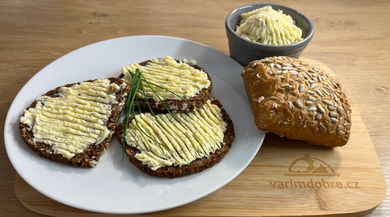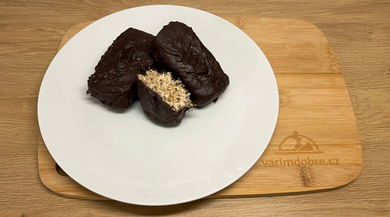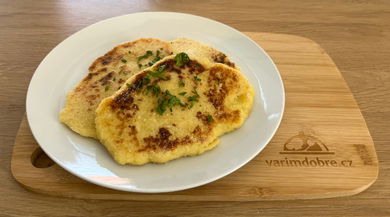Bread dumplings
Bread dumplings are an essential part of Czech cuisine. They perfectly accompany dishes like "svíčková" (creamy beef sauce), goulash, and many other traditional meals.
Ingredients:
- 500 grams wheat flour (medium)
- 250 milliliters milk
- 1 tablespoon sugar
- 1 teaspoon salt
- 100 grams white pastry (cubed)
- 2 pieces chicken egg
- 0,50 cubes yeast (42 g)
Nutrition values (per 100 g):
| Energy | 244 kcal 1 022 kJ | |
|---|---|---|
| Protein | 8,5 g | |
| Carbohydrates | 45,9 g | |
| - of which sugars | 3,4 g | |
| Fat | 2,3 g | |
| - saturated fat | 0,8 g | |
| - trans fat | 0,0 g | |
| - monounsaturated fat | 0,6 g | |
| - polyunsaturated fat | 0,5 g | |
| - cholesterol | 37,3 mg | |
| Fiber | 1,9 g | |
| Salt | 0,8 g | |
All nutritional data is approximate and subject to variation based on ingredient choice, brand, and measured amounts.
By clicking the table, you switch the view.
Nutrition values (for the whole recipe):
| Energy | 2 438 kcal 10 203 kJ | |
|---|---|---|
| Protein | 85,1 g | |
| Carbohydrates | 458,1 g | |
| - of which sugars | 34,4 g | |
| Fat | 23,0 g | |
| - saturated fat | 7,7 g | |
| - trans fat | 0,1 g | |
| - monounsaturated fat | 5,8 g | |
| - polyunsaturated fat | 5,2 g | |
| - cholesterol | 372 mg | |
| Fiber | 19,5 g | |
| Salt | 7,98 g | |
All nutritional data is approximate and subject to variation based on ingredient choice, brand, and measured amounts.
By clicking the table, you switch the view.
Recipe steps:
- Cut the stale bread rolls into small cubes and set aside. Using slightly stale bread helps the dumplings keep the right texture.
- In a large bowl, combine the flour, milk, eggs, yeast, a pinch of salt, and sugar. Mix and knead well until you get a smooth dough.
- Work in the bread cubes and knead again. The dough should be elastic but not too sticky.
- Cover the bowl with a clean kitchen towel and let the dough rise in a warm place until it doubles in size (about 45–60 minutes).
- Transfer the risen dough onto a floured surface and divide it into three equal parts. Roll each into a log shape and let them rest, covered with a towel, for another 15 minutes.
- Bring a large pot of water to a boil. Carefully place the dumplings into the boiling water and cook for 10 minutes. Turn them over and cook for another 10 minutes.
- Remove the dumplings from the water and slice them immediately with thread to keep them fluffy. If slicing later, use a sharp knife.
Story and background:
Czech bread dumplings known as houskové knedlíky are a hallmark of traditional meals. They began as a smart way to use day old rolls and grew into the fluffy partner for sauces and roasts. A good dumpling holds its shape, shows a fine open crumb and carries gravy without falling apart.
How they taste and why they work:
The dough blends flour, milk and eggs with yeast. During proofing yeast creates tiny bubbles that cook into a tender network of pores. Cubes of bread add a gentle toasty note and strengthen the slice. The texture is soft yet steady so each piece soaks up sauce beautifully.
Dough technique:
Use lukewarm milk to wake the yeast. Sift the flour so it hydrates evenly. Knead to a smooth elastic dough that is only lightly tacky. Fold in the bread cubes at the end so they stay distinct. Let the dough rise until roughly doubled. It should feel springy and alive to the touch.
Shaping and cooking:
Form even logs and let them rest so the surface tightens. Bring salted water to a gentle boil. Lower the logs in carefully and give them a small turn in the first minute to prevent sticking. Keep the simmer quiet and cover the pot. Turn the dumplings halfway through. When cooked, vent with a skewer to release steam and slice right away with thread or a wire for clean edges and a tender crumb.
Variations and ideas:
For a firmer bite add a spoon of fine semolina. For a softer crumb swap a part of the flour for plain flour. Toast cubes made from soft white rolls or use crustless toast. Steaming gives a very even result and a silky surface. Chopped parsley in the dough makes a fresh side for roast chicken.
Serving:
These dumplings are a classic partner for creamy sauces, paprika gravies and beef goulash. They sit neatly on the plate and soak up every drop.
Storage and reheating:
Keep cooked slices covered so they do not dry out. Reheat gently over steam to bring back the softness. They freeze well. Slice before freezing and warm from thawed in steam or with a touch of butter in a pan.
Helpful answers:
- My dumplings feel dense? The dough likely proofed too little or was mixed too stiff. Add a splash more milk and allow a longer rise.
- The logs crack? The simmer was too strong or the logs did not rest before cooking. Use a calmer simmer and give them a short bench rest.
- Slices stick to the knife? Cut with thread right after cooking. Flattened pores mean the dumplings cooled without releasing steam, vent with a skewer as soon as they come out.



